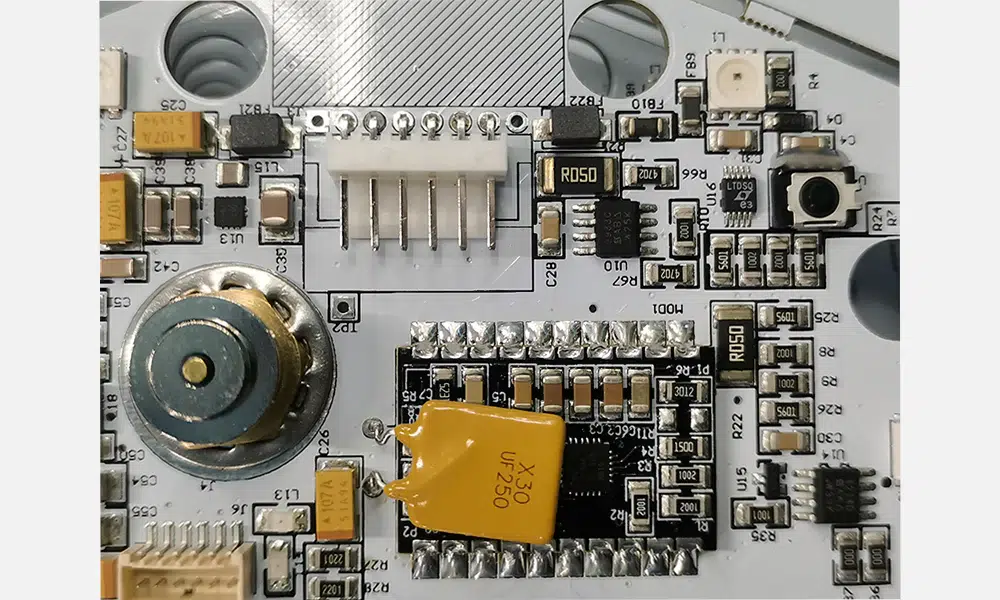In the rapidly developing world of modern technology, we can see a variety of electronic devices everywhere. The core of electronic equipment is the PCBA board, which carries various electronic components and is therefore known as the “brain” of electronic equipment. So, what exactly are the electronic components on the PCBA board? This article will reveal the secrets to you.
PCBA, Printed Circuit Board Assembly, is a printed circuit board based on electronic components to complete the assembly and soldering of components. It integrates various types and specifications of electronic components on a small board to achieve electrical and signal connections. Therefore, PCBA board can be said to be one of the cores of electronic equipment.
On the PCBA board, we can find a variety of electronic components. Their functions are unique and they cooperate with each other to ensure the normal operation of electronic equipment. Next, we learn about these electronic components one by one.

1.Resistor
Resistors are electronic components with resistive characteristics and are one of the most widely used components in PCBA processing. Resistors are divided into fixed resistors and variable resistors (potentiometers), which play the roles of voltage dividing, current shunting and current limiting in the circuit.
2. Capacitor
Capacitor is also one of the basic components in PCBA processing. It is a component that stores electrical energy and plays a role in coupling, filtering, DC isolation and tuning in electronic circuits.
3. Inductor coil
Inductor coil, referred to as inductor, has the function of storing magnetic energy. Inductor coils are usually composed of skeleton, windings, shields, magnetic cores, etc.
4.Potentiometer
A resistor whose resistance can change, that is, a resistor that can be continuously adjusted within a specified range, is called a potentiometer. The potentiometer consists of a shell, a sliding end, a rotating shaft, a ring resistor and 3 leads.
5. Transformer
The transformer consists of an iron core (or magnetic core) and a coil. The coil has two or more windings. The winding connected to the power supply is called the primary coil, and the remaining windings are called secondary wires.
A transformer is a device that converts voltage, current and impedance. When AC current flows through the primary coil, AC magnetic flux is generated in the iron core (or magnetic core), causing voltage (or current) to be induced in the secondary coil. Transformers are mainly used for AC voltage conversion, current conversion, power transfer, impedance conversion, buffer isolation, etc. They are one of the indispensable and important components in the PCBA machine.
6. Crystal diode
A crystal diode (semiconductor diode, hereinafter referred to as a diode) is made of a PN junction, electrode leads and an external sealed tube. It has unidirectional conductive characteristics.
7. Transistor
Transistor (hereinafter referred to as transistor) is the core device for signal amplification and processing, and is widely used in PCBA and electronic products.
8. Field effect transistor
A field effect transistor (referred to as a field effect transistor) is also a semiconductor device with a PN junction. Unlike a triode, it does not use the conductive properties of the PN junction, but its insulating properties.
9.Electroacoustic devices
Devices used in circuits to complete the mutual conversion of electrical signals and sound signals are called electroacoustic devices. There are many types, including speakers, microphones, headphones (or earplugs), microphones, receivers, etc.
10. Optoelectronic devices
Photoconductive devices that work using the photosensitive properties of semiconductors, photovoltaic cells and semiconductor light-emitting devices that work using the photovoltaic effect of semiconductors are collectively called optoelectronic devices.
11.Display device
Electronic display devices refer to photoelectric conversion devices that convert electrical signals into optical signals, that is, devices used to display numbers, symbols, text or images. It is a key component of the electronic display device and has a great impact on the performance of the display device.
12. Sensor
A sensor is a device or device that can sense the specified measured value and convert it into a usable signal according to certain rules. It is usually composed of a sensitive element and a conversion element.
13. Surface mount components
Surface mounted components (SMC and SMD) are also called patch components or chip components. They include resistors, capacitors, inductors and semiconductor devices, etc. They have the characteristics of small size, light weight, no leads or very short leads, It has the characteristics of high installation density, high reliability, good vibration resistance and easy automation.
14.Silicon controlled
Thyristor, the abbreviation of silicon-controlled rectifier element, is a high-power semiconductor device with a four-layer structure with three PN junctions, also called a thyristor. It has the characteristics of small size, relatively simple structure, and strong functions, and is one of the more commonly used semiconductor devices.
15. Switches, relays, various connectors
Switches are used in electronic equipment to cut off, connect or convert circuits. A relay is an automatic control device that will cause a jump change in the output when the input (electricity, magnetism, sound, light, heat) reaches a certain value.
Through the above introduction, we can see that there are many types of electronic components on the PCBA board, and they each play an important role. It is the coordinated work of these electronic components that enables electronic equipment to operate normally. Therefore, the selection and matching of electronic components on the PCBA board is very critical.
Today, with the increasing development of the electronics industry, PCBA boards have become the core of various electronic devices. Understanding the electronic components on the PCBA board helps us better understand and use electronic equipment. I hope this article can unveil the mystery of electronic components for you and increase your knowledge base.










